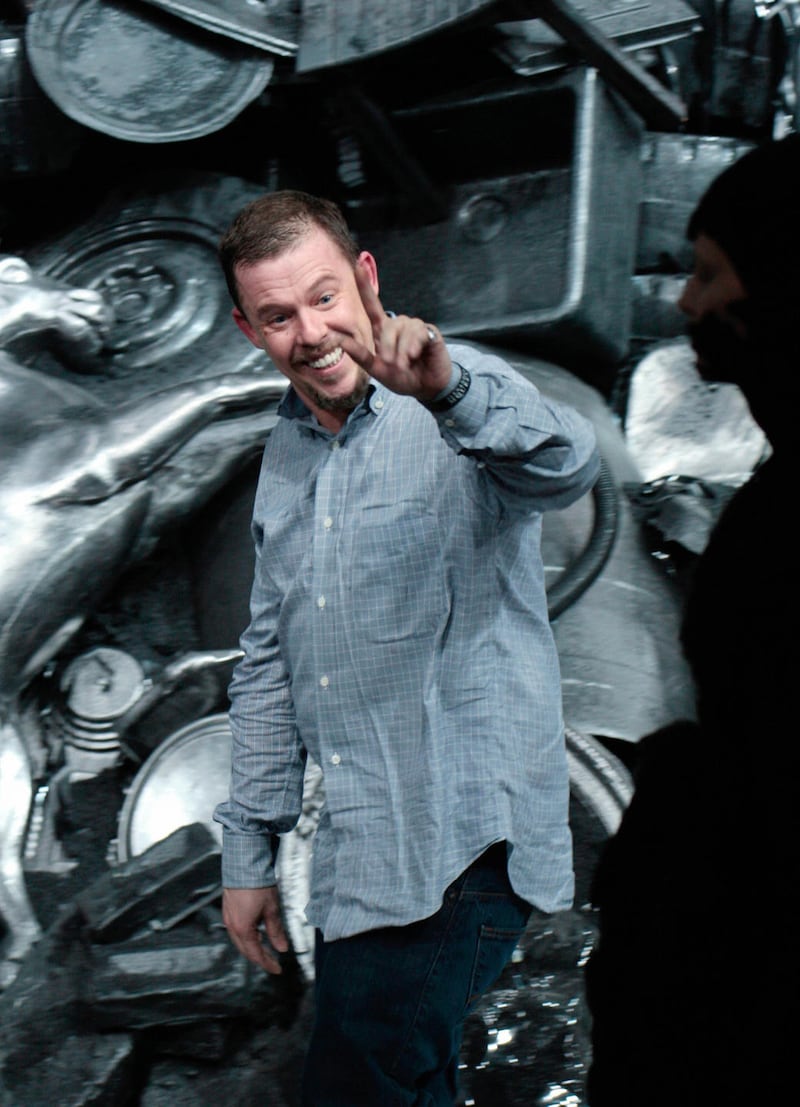
It should have been a triumphant moment. It was a chill October evening in Paris, and
Alexander McQueen
0 of 3
had just showed Plato’s Atlantis, his universally praised spring-summer 2010 collection. The clothing was an incredibly sophisticated synthesis of thought and technology. McQueen’s central thesis was Darwinism in reverse; a provocative meditation on the notion “What if, instead of humans coming out of the sea, we went back in?”
From this apocalyptic image, beauty was born. Models wore expertly cut, shimmering reptilian print dresses. Pictures were abstracted and refracted upon each other; one dress gave the impression of a butterfly’s wing through a kaleidoscope, another an insect’s proboscis melted and warped to resemble lava. The heels were 10in, helmeted monstrosities that resembled armour. Models were given insectile make-up looks, adding to their hard, uncrackable appearance. It was a logical progression of McQueen’s sinister twin credos of romance and violence. “I want people to be afraid of the women I dress,” he said in interviews.
Behind the scenes, the designer was a mess, struggling with substance addiction and the terminal illness of his beloved mother, Joyce. On February 1st, 2010, he wrote on Twitter, “ From heaven to hell and back again, life is a funny thing. beauty can come from the most strangest of places, even the most disgusting places.” On February 11th, the day before his mother’s funeral, the designer was dead.
Forbidding question
The grotesque interest in the details of McQueen’s suicide has resulted in the kind of ghoulishly inappropriate martyrdom that is too often misplaced; designated to creative, tortured people who take their own lives. Now, almost five years to the day since his death, the fashion designer’s life and work are being excavated in equal measure. One forbidding question looms on the horizon: whether the dark details of a fashion auteur’s life can overshadow a remarkable body of work.
Lee Alexander McQueen was born on St Patrick’s Day in 1969. He was the youngest of six and grew up in a crowded home in Stratford, east London. He left school at an early age and started an apprenticeship at Anderson & Sheppard of Savile Row, who were tailors to the Prince of Wales among others.
His training gave him an edge, which led to an offer to study fashion design at Central Saint Martins in London. His graduate collection caught the eye of influential stylist Isabella Blow, who bought it in its entirety. The two enjoyed a symbiotic relationship until McQueen's success became a wedge between them.
The velocity of McQueen's ascent became a burden. As well as several collections a year for his own label, he was also appointed head designer of Givenchy at the age of 27. He was essentially double-jobbing for much of his career, which would have a huge impact on his mental health. McQueen developed serious substance abuse issues due in no small part to this workload. Cocaine became a crutch to help him get work done. In the months before his death, he overdosed twice. Rumours swirled about his habits, his tastes, his self-destructive behaviour.
McQueen’s output was astonishing in creativity, relevance and covetousness: the holy trinity of fashion. His work struck that magical balance between critical success and wearability. Clothing that was outlandish on the catwalk would be pared down for department stores, all the while retaining the impeccable McQueen tailoring. People bought in droves.
Major retrospective
A major retrospective of McQueen's work, Savage Beauty, is a continuation of the exhibition of the same name held in New York's Metropolitan Museum of Art in 2011, which shattered exhibition attendance records. The London exhibition, held at the Victoria and Albert Museum, will include a new section focusing on McQueen's early work, 30 additional garments and a recreation of his Widows of Culloden (autumn-winter 2006-2007) show. The accompanying book, edited by the V&A's senior fashion curator, Claire Wilcox, is destined to become a seminal text.
Coinciding with Savage Beauty is Tate Modern's Working Process, an exhibition of photos taken by Nick Waplington that documents the creative process behind McQueen's final autumn-winter collection, The Horn of Plenty. Waplington was given unprecedented access to the designer, resulting in a body of work that best represented the man at work.
Also out are two biographies of the designer, which have been met with mixed reactions. God and Kings, a joint biography of John Galliano and McQueen by Dana Thomas, is a no-holds-barred affair that is overdependent on the recollections of acquaintances. In parts, the dissection of more pitiful details is borderline gleeful. Alexander McQueen: Blood Beneath the Skin by Andrew Wilson is a more reasoned, better researched biography. Nevertheless, both books concentrate on the life over the clothes: a risky choice given the subject matter and how fiercely protective the fashion fold is.
Five years after the designer’s death, it is ultimately down to the public to determine how McQueen is remembered: as a difficult, tormented man or a genius who kick-started the 21st century.
Either way, there is plenty of material to ruminate upon.
Savage Beauty is at Victoria and Albert Museum, London, March 14th to August 2nd. Working Process is at Tate Britain, March 10th-17th




















